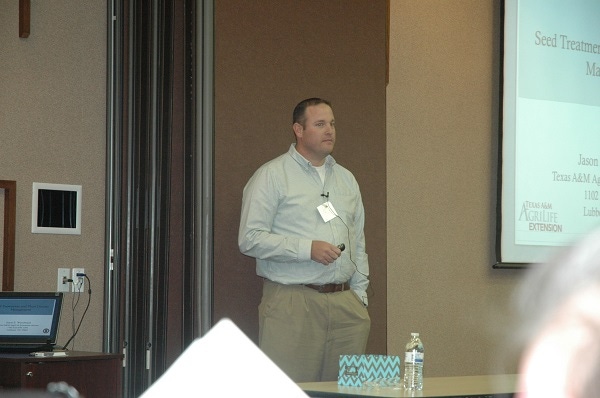
Cotton farmers do not have a substitute for Temik (aldicarb) that provides equal control of nematodes and other pests, but they can improve their odds with seed treatments, resistant varieties and cultural practices.
“After the loss of Temik in 2012 we’ve seen a resurgence in root-knot nematodes in the Texas High Plains and the Rolling Plains,” said Jason Woodward, Texas AgriLife Extension pathologist, Lubbock. Temik had been widely used to control thrips but also kept nematode levels down. “We now have a void in nematode and thrips control,” Woodward said during the cotton section of the recent Red River Crops Conference in Altus, Okla.
He said researchers are now evaluating new chemistries and use of older materials as well as looking at new, tolerant or resistant varieties to help manage mainly the nematode, which can cause significant damage to cotton.
For more on cotton production practices, please check out Southwest Farm Press Daily and receive the latest news right to your inbox.
“Root knot nematodes are mostly sedentary. They initiate feeding sites within the roots and disrupt the ability of the roots to acquire water and nutrients. New fields have been identified following fertilizer applications. Later we can see stunted plants, poor vigor and premature wilting.”
Variety selection critical for cotton.
He said the female reproduces asexually, as many as 500 eggs, which have a fast maturation period. “They can go from egg to egg in just 30 days.”
A mapping program is underway to identify where heavy concentrations occur in the High Plains. “Our ultimate goal is to identify counties with nematode populations and assess the relative risk for root knot nematode damage.” Assessment will include interactive maps.
Management strategies are also unfolding and include chemical applications, rotation and variety selection. He said several varieties are currently available with root knot nematode tolerance and several others are either coming out this year or will be available soon.
Options include: Stoneville 5458B2F, Stoneville 4946GLB2, Phytogen 367WRF, FiberMax 2011GT and Deltapine 1454NR B2RF.
“We’re looking at yields from nematode susceptible and resistant lines,” Woodward said. “Resistant varieties are decreasing nematode numbers in addition to improving yields.”
He recommends an integrated pest management approach to nematode control. “Growers are doing a lot of things right,” he said. Rotation helps, as does using resistant varieties and occasionally seed treatments.
“One chink in the armor we’ve seen is weed control,” Woodward added. “Root knot nematode may survive on some weeds, Russian thistle, for instance. We are trying to determine the potential for population and reproduction of root knot nematodes on Russian thistle.”
He said peanut is the best non-host rotation crop. Root knot nematodes will reproduce on grain sorghum and wheat, “but not as much. However, cotton following corn can have heavy nematode pressure. The corn suffers no damage but the nematodes can hit a subsequent cotton crop hard.”
Seedling diseases
Woodward also commented on cotton seedling diseases, which are typically worse under cool, wet conditions. The last three growing seasons have been hot and dry, but Woodward said disease pressure has also been heavy. “With center pivot units running continually, we lower the soil temperature and provide a favorable environment for disease in susceptible varieties. The micro climate has been a factor.”
He said abiotic stress—drought and heat—has resulted in more disease pressure.
Weather makes a difference. “We had good conditions in 2007 to test seedling disease and we showed the value of seed treatments.”
Cotton farmers who plant early to reduce later risks or to cover a large number of acres may want to consider seed treatment. “We also see the value of ‘premium treatments’ with extended risk,” he said. Even with the advantage of premium treatments in protecting the crop, Woodward said a yield boost is not typical.
“We are happy with the standard products if conditions warrant,” he said. With more risk, premium treatment packages may be better options.
He said cotton root rot is not a common problem in the Texas High Plains but may show up in the Rolling Plains and can be a devastating disease causing heavy yield loss and harvest problems as cotton stalks pull loose from the soil and clog up harvesters.
Contributing to the problem is the wide range of pathogen hosts. Woodward said as many as 2,500 plants may serve as hosts to the root rot pathogen. Until recently, cotton farmers were limited to rotation as a management strategy. That can still be part of an overall management plan, but Texas A&M AgriLife Extension pathologist Tom Isakeit, College Station, has identified a fungicide, Topguard (flutriafol), which offers control of the disease.
“Trials have shown significant reduction in the amount of the disease and researchers are seeing substantial yield increases, from 300 to 400 pounds per acre. Harvest efficiency is also improved.”
Ongoing studies are looking at application methods, timing, rates and potential for phytotoxicity.
Woodward said with either a disease or a nematode problem, cotton farmers should be alert to crop progress and possible problems. “Know your enemy,” he said. “Knowing is half the battle.”
More on Southwest crop production:
Go back to yellows for resistant weed control in cotton
About the Author(s)
You May Also Like






